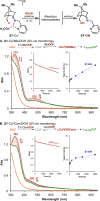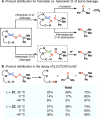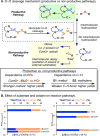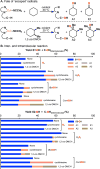Decoding the Mechanism of Intramolecular Cu-Directed Hydroxylation of sp3 C-H Bonds
- PMID: 28654755
- PMCID: PMC5792191
- DOI: 10.1021/acs.joc.7b01069
Decoding the Mechanism of Intramolecular Cu-Directed Hydroxylation of sp3 C-H Bonds
Abstract
The use of copper in directed C-H oxidation has been relatively underexplored. In a seminal example, Schönecker showed that copper and O2 promoted the hydroxylation of steroid-containing ligands. Recently, Baran (J. Am. Chem. Soc. 2015, 137, 13776) improved the reaction conditions to oxidize similar substrates with excellent yields. In both reports, the involvement of Cu2O2 intermediates was suggested. In this collaborative article, we studied the hydroxylation mechanism in great detail, resulting in the overhaul of the previously accepted mechanism and the development of improved reaction conditions. Extensive experimental evidence (spectroscopic characterization, kinetic analysis, intermolecular reactivity, and radical trap experiments) is provided to support each of the elementary steps proposed and the hypothesis that a key mononuclear LCuII(OOR) intermediate undergoes homolytic O-O cleavage to generate reactive RO• species, which are responsible for key C-H hydroxylation within the solvent cage. These key findings allowed the oxidation protocol to be reformulated, leading to improvements of the reaction cost, practicability, and isolated yield.
Conflict of interest statement
The authors declare no competing financial interest.
Figures















Similar articles
-
Cu-promoted intramolecular hydroxylation of CH bonds using directing groups with varying denticity.J Inorg Biochem. 2021 Oct;223:111557. doi: 10.1016/j.jinorgbio.2021.111557. Epub 2021 Jul 20. J Inorg Biochem. 2021. PMID: 34352714 Free PMC article.
-
Substrate and Lewis Acid Coordination Promote O-O Bond Cleavage of an Unreactive L2CuII2(O22-) Species to Form L2CuIII2(O)2 Cores with Enhanced Oxidative Reactivity.J Am Chem Soc. 2017 Mar 1;139(8):3186-3195. doi: 10.1021/jacs.6b12990. Epub 2017 Feb 14. J Am Chem Soc. 2017. PMID: 28195739 Free PMC article.
-
Developing mononuclear copper-active-oxygen complexes relevant to reactive intermediates of biological oxidation reactions.Acc Chem Res. 2015 Jul 21;48(7):2066-74. doi: 10.1021/acs.accounts.5b00140. Epub 2015 Jun 18. Acc Chem Res. 2015. PMID: 26086527
-
[CuO](+) and [CuOH](2+) complexes: intermediates in oxidation catalysis?Acc Chem Res. 2015 Jul 21;48(7):2126-31. doi: 10.1021/acs.accounts.5b00169. Epub 2015 Jun 15. Acc Chem Res. 2015. PMID: 26075312 Free PMC article. Review.
-
Inhibition and oxygen activation in copper amine oxidases.Acc Chem Res. 2015 May 19;48(5):1218-26. doi: 10.1021/ar500460z. Epub 2015 Apr 21. Acc Chem Res. 2015. PMID: 25897668 Review.
Cited by
-
Site-selective C-H hydroxylation of pentacyclic triterpenoids directed by transient chiral pyridine-imino groups.Nat Commun. 2020 Sep 1;11(1):4371. doi: 10.1038/s41467-020-18138-9. Nat Commun. 2020. PMID: 32873790 Free PMC article.
-
Copper-Promoted Functionalization of Organic Molecules: from Biologically Relevant Cu/O2 Model Systems to Organometallic Transformations.Chem Rev. 2019 Feb 27;119(4):2954-3031. doi: 10.1021/acs.chemrev.8b00368. Epub 2019 Jan 30. Chem Rev. 2019. PMID: 30698952 Free PMC article. Review.
-
Enabling a bioinspired N,N,N-copper coordination motif through spatial control in UiO-67: synthesis and reactivity.Dalton Trans. 2024 May 14;53(19):8141-8153. doi: 10.1039/d3dt03096b. Dalton Trans. 2024. PMID: 38483202 Free PMC article.
-
Methylene C(sp3)-H Arylation of Aliphatic Ketones Using a Transient Directing Group.ACS Catal. 2017 Oct 6;7(10):6938-6941. doi: 10.1021/acscatal.7b02905. Epub 2017 Sep 13. ACS Catal. 2017. PMID: 29038742 Free PMC article.
-
Expanding the Clip-and-Cleave Concept: Approaching Enantioselective C-H Hydroxylations by Copper Imine Complexes Using O2 and H2O2 as Oxidants.J Am Chem Soc. 2024 Sep 18;146(37):25689-25700. doi: 10.1021/jacs.4c07777. Epub 2024 Sep 6. J Am Chem Soc. 2024. PMID: 39240225 Free PMC article.
References
-
- Gutekunst WR, Baran PS. Chem Soc Rev. 2011;40:1976. - PubMed
Publication types
MeSH terms
Substances
Grants and funding
LinkOut - more resources
Full Text Sources
Other Literature Sources
Research Materials

